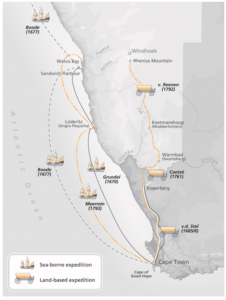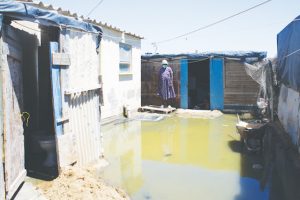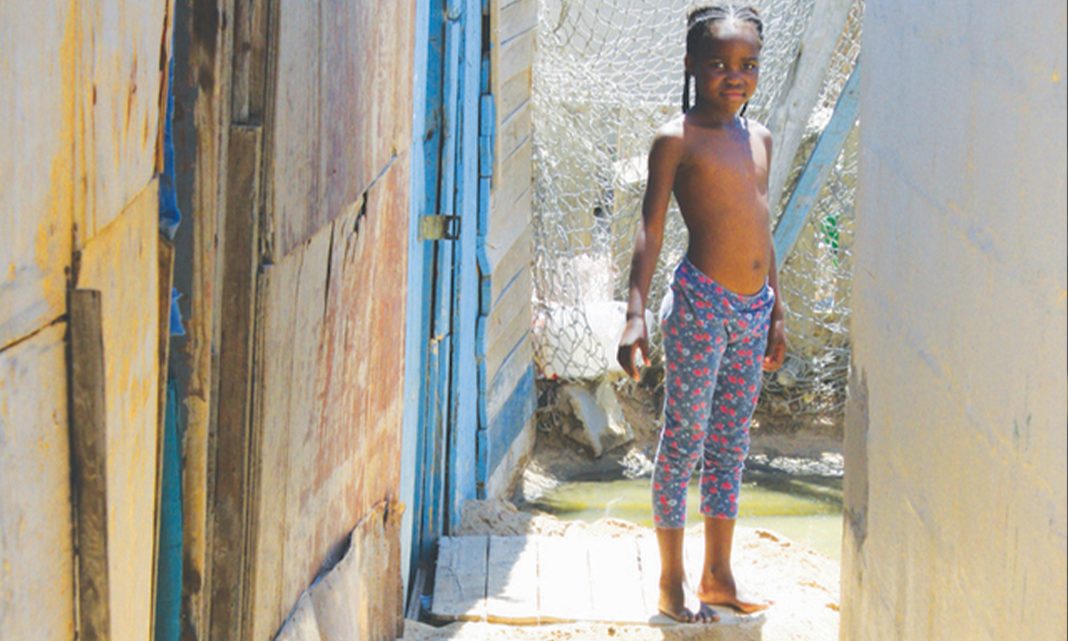By Ester Mbathera| 3 March 2021
WHEN Werner Kartyoa bought his first house at Kuisebmond 19 years ago, he thought he finally found a place to call home.
However, not long after Kartyoa and his family moved in, they discovered sewage leaking – a nightmare which he says has forced him and his family to move elsewhere.
“I bought this house in 2002 and since then I had this drain problem. My children live with their aunt because the yard is a health risk,” he says.
Kartyoa says the previous owner of the house did not raise the issue of overflowing sewage with him.
When the street’s sewerage pipe is blocked, the drain in Kartyoa’s yard, which is situated in a low-lying area, overflows with untreated sewage, he says.
This then flows into the yard next door, causing animosity between him and his neighbours.
“There are days when it overflows very strongly and when the sewage water makes a pool around the house. Then no one can enter or leave the yard. Even in the kitchen . . . the gases from the system comes up through the sink, leaving a terrible stench in the house,” Kartyoa says.
He says he often informs the municipality about the problem, upon which they send a truck to pump the sewage out, leaving him to deal with the residue.
Kartyoa says he has written numerous letters to the municipality.
“I pay the municipality for sewage to go through the system . . . but it comes back to me untreated, and I have to pay for that too,” he says.
Kartyoa refuses to sell his house, saying he does not want to pass the problem on to the next owner.
On Hematiet Street on the northern side of Kuisebmend, tenants in three backyard shacks get trapped in their homes by sewage water every other day. This neighbourhood is not more than 20 years old but overflowing drains are a common occurrence.
Johana Tjaveondja, the home-owner of the sewage flooded yard, blames this on the main sewage pipe that is always clogged.
“When the main pipe gets blocked the sewage water comes through here. The people have to step over the bricks to move around,” she said.
She has been waiting for the municipality sewage workers to come address the problem.
HISTORY
According to archives, Walvis Bay was founded in the 1790s by Dutch traders from Cape Town en route to the Netherlands.

Infrastructure development included a railway line in 1899. Most infrastructure was rebuilt after a flood in 1917.
This led to more developments at the town, including the construction of the harbour.
Most infrastructure development, such as that of the sewerage pipes, manholes, pump and lift stations, took place around 1961.
The Namibian visited John Esterhuizen, the general manager for wastewater and environmental management at the Walvis Bay municipality, whose office is next to the sewage reclamation plant.
Esterhuizen says the plant has reached its expiry date, failing and collapsing without warning, causing sinkholes and a disruption in the flow of sewage at the town.
“ . . . some of our infrastructure is over 50 years old, so it is due for replacement,” he says.
The town was historically divided into three regions, each with its own municipal administration.
The town’s centre was predominantly a white area, with Kuisebmond and Narraville accommodating blacks and coloureds, respectively.
When Namibia gained independence in 1990, Walvis Bay remained South African territory and was reintegrated with Namibia in 1994.
Documentation for the town is kept at unknown locations in Cape Town, and engineers, including Esterhuizen who has been with the municipality for less than five years, are still acquainting themselves with the local sewerage system.
CHALLENGES
Esterhuizen says a major challenge for Walvis Bay is its geographical location.
The town is flat and as a result has to use pump stations to move sewage throughout the area.
The expansion of residential areas, he says, contributes to overloading the network serving a population greater than what it was initially designed for.
Esterhuizen says this leads to overflowing sewage on a daily or weekly basis in some areas of the town.
The Namport location is just over 20 years old, but because most of the houses in the area accommodate over 10 backyard shacks with one toilet often serving more than 20 people, the overflow of sewage at its entrance is a weekly occurrence.

Locals call it the ‘Vrydagrivier’ or ‘Friday River’.
The occasional east wind, which brings with it a lot of sand, is another challenge the town’s engineers are constantly battling, Esterhuizen says.
IMPACT ON HOUSING MARKET
According to the National Statistics Agency’s 1993/94 household expenditure and income survey, Walvis Bay’s population at the time stood at 21 000 people.
Some 6% of these people lived at Kuisebmond, 26% at Narraville, and 14% at Walvis Bay’s centre and Langstrand.
Today the town’s population is estimated to be over 50 000 people.
Corné Robberts of Grobbies Estates, one of the oldest estate agents at the town, says the sewage problem is a deal breaker when it comes to house sales and rentals.
“You get tenants who give up their lease agreement because they can’t deal with the sewage problem . . .
“Every time you go and show a client, and there is a sewage spill, you will most definitely sit with the property for a year and a half plus, before you can sell it. Unless someone is really desperate and they drop the price . . ,” Robberts says.
SOLUTION
Esterhuyzen says the municipality has the capacity to handle the sewerage system problem, but is faced with financial capacity challenges to finding a lasting solution.
The current approach is to fix areas needing urgent attention, he says.
The municipality has also resorted to educating residents on what can go into the sewerage system and what not, he says.
*This story was produced with the assistance of the Google Grant.






